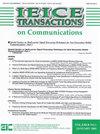Highly Efficient Multi-Band Optical Networks with Wavelength-Selective Band Switching
IF 0.7
4区 计算机科学
Q3 Engineering
引用次数: 0
Abstract
SUMMARY Multi-band transmission technologies promise to cost-e ff ectively expand the capacity of optical networks by exploiting low-loss spectrum windows beyond the conventional band used in already-deployed fibers. While such technologies o ff er a high potential for capacity upgrades, available capacity is seriously restricted not only by the wavelength-continuity constraint but also by the signal-to-noise ratio (SNR) constraint. In fact, exploiting more bands can cause higher SNR imbalance over multiple bands, which is mainly due to stimulated Raman scattering. To relax these constraints, we propose wavelength-selective band switching-enabled networks (BSNs), where each wavelength channel can be freely switched to any band and in any direction at any optical node on the route. We also present two typical optical node configurations utilizing all-optical wavelength converters, which can realize the switching proposal. Moreover, numerical analyses clarify that our BSN can reduce the fiber resource requirements by more than 20% compared to a conventional multi-band network under realistic conditions. We also discuss the impact of physical-layer performance of band switching operations on available benefits to investigate the feasibility of BSNs. In addition, we report on a proof-of-concept demonstration of a BSN with a prototype node, where C + L-band wavelength-division-multiplexed 112-Gb / s dual-polarization quadrature phase-shift keying signals are successfully transmitted while the bands of individual channels are switched node-by-node for up to 4 cascaded nodes.具有波长选择性频带交换的高效多波段光网络
多频段传输技术有望通过利用低损耗频谱窗口,在已部署的光纤中使用的传统频段之外,以低成本有效地扩展光网络的容量。虽然这些技术具有很大的容量升级潜力,但可用容量不仅受到波长连续性的限制,而且受到信噪比(SNR)的限制。事实上,利用更多的波段会导致多个波段的信噪比失衡,这主要是受激拉曼散射造成的。为了放松这些限制,我们提出了波长选择性频带交换网络(BSNs),其中每个波长通道可以在路由上的任何光节点上自由切换到任何频带和任何方向。我们还提出了两种典型的利用全光波长转换器的光节点配置,可以实现交换方案。此外,数值分析表明,在现实条件下,与传统的多频段网络相比,我们的BSN可以减少20%以上的光纤资源需求。我们还讨论了物理层性能对可用收益的影响,以研究bsn的可行性。此外,我们报告了一个具有原型节点的BSN的概念验证演示,其中C + l波段波分复用112 gb / s双极化正交相移键控信号成功传输,同时单个信道的频带在多达4个级联节点上逐节点切换。
本文章由计算机程序翻译,如有差异,请以英文原文为准。
求助全文
约1分钟内获得全文
求助全文
来源期刊

IEICE Transactions on Communications
ENGINEERING, ELECTRICAL & ELECTRONIC-TELECOMMUNICATIONS
CiteScore
1.50
自引率
28.60%
发文量
101
期刊介绍:
The IEICE Transactions on Communications is an all-electronic journal published occasionally by the Institute of Electronics, Information and Communication Engineers (IEICE) and edited by the Communications Society in IEICE. The IEICE Transactions on Communications publishes original, peer-reviewed papers that embrace the entire field of communications, including:
- Fundamental Theories for Communications
- Energy in Electronics Communications
- Transmission Systems and Transmission Equipment for Communications
- Optical Fiber for Communications
- Fiber-Optic Transmission for Communications
- Network System
- Network
- Internet
- Network Management/Operation
- Antennas and Propagation
- Electromagnetic Compatibility (EMC)
- Wireless Communication Technologies
- Terrestrial Wireless Communication/Broadcasting Technologies
- Satellite Communications
- Sensing
- Navigation, Guidance and Control Systems
- Space Utilization Systems for Communications
- Multimedia Systems for Communication
 求助内容:
求助内容: 应助结果提醒方式:
应助结果提醒方式:


